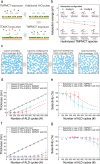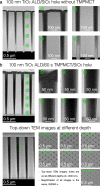Gradient area-selective deposition for seamless gap-filling in 3D nanostructures through surface chemical reactivity control
- PMID: 36494441
- PMCID: PMC9734176
- DOI: 10.1038/s41467-022-35428-6
Gradient area-selective deposition for seamless gap-filling in 3D nanostructures through surface chemical reactivity control
Erratum in
-
Publisher Correction: Gradient area-selective deposition for seamless gap-filling in 3D nanostructures through surface chemical reactivity control.Nat Commun. 2023 Jan 12;14(1):184. doi: 10.1038/s41467-023-35883-9. Nat Commun. 2023. PMID: 36635326 Free PMC article. No abstract available.
Abstract
The integration of bottom-up fabrication techniques and top-down methods can overcome current limits in nanofabrication. For such integration, we propose a gradient area-selective deposition using atomic layer deposition to overcome the inherent limitation of 3D nanofabrication and demonstrate the applicability of the proposed method toward large-scale production of materials. Cp(CH3)5Ti(OMe)3 is used as a molecular surface inhibitor to prevent the growth of TiO2 film in the next atomic layer deposition process. Cp(CH3)5Ti(OMe)3 adsorption was controlled gradually in a 3D nanoscale hole to achieve gradient TiO2 growth. This resulted in the formation of perfectly seamless TiO2 films with a high-aspect-ratio hole structure. The experimental results were consistent with theoretical calculations based on density functional theory, Monte Carlo simulation, and the Johnson-Mehl-Avrami-Kolmogorov model. Since the gradient area-selective deposition TiO2 film formation is based on the fundamentals of molecular chemical and physical behaviours, this approach can be applied to other material systems in atomic layer deposition.
© 2022. The Author(s).
Conflict of interest statement
The authors declare no competing interests.
Figures





References
-
- Johnson RW, Hultqvist A, Bent SF. A brief review of atomic layer deposition: from fundamentals to applications. Mater. Today. 2014;17:236–246. doi: 10.1016/j.mattod.2014.04.026. - DOI
-
- Cremers V, Puurunen RL, Dendooven J. Conformality in atomic layer deposition: current status overview of analysis and modelling. Appl. Phys. Rev. 2019;6:021302. doi: 10.1063/1.5060967. - DOI
-
- Kim H, Lee H-B-R, Maeng W-J. Applications of atomic layer deposition to nanofabrication and emerging nanodevices. Thin Solid Films. 2009;517:2563–2580. doi: 10.1016/j.tsf.2008.09.007. - DOI
-
- Lee H-B-R, Mullings MN, Jiang X, Clemens BM, Bent SF. Nucleation-controlled growth of nanoparticles by atomic layer deposition. Chem. Mater. 2012;24:4051–4059. doi: 10.1021/cm3014978. - DOI
-
- Kim YR, et al. Fluorine-containing polymeric inhibitor for highly selective and durable area-selective atomic layer deposition. Appl. Surf. Sci. 2022;578:152056. doi: 10.1016/j.apsusc.2021.152056. - DOI
LinkOut - more resources
Full Text Sources
Miscellaneous

